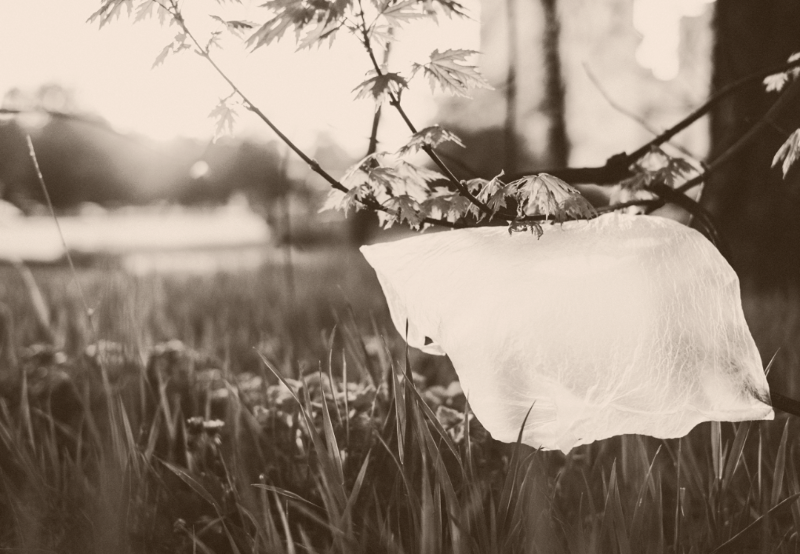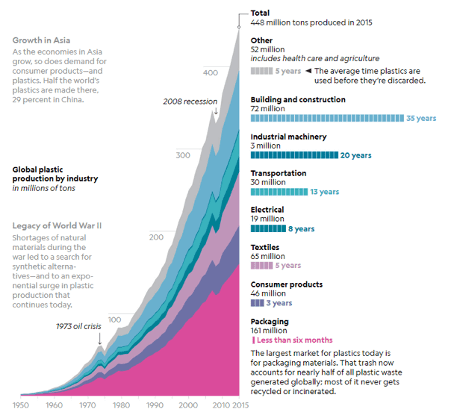The Opportunities Of Plastic Pollution

The Opportunities Of Plastic Pollution
Plastic pollution is one of the biggest global issues to tackle in today’s high consuming and producing world. As the negative environmental and social impacts are increasing, so does the overall awareness of this issue. Plastics can be seen as both a huge challenge and a huge opportunity for a sustainable future. It becomes especially interesting when there are solutions in place that could seize the challenges, and take initiative on the opportunities.
In 2015 the world produced more than 448 million tonnes of plastic. China is the biggest producer of plastics being responsible for more than half of total production. Europe comes second and is accountable for a little less than 20% of total production. More than half of all the plastic produced goes straight into landfill, ending up as plastic pollution.
Lifetime of plastic

Source: Roland Geyer, University of California
Plastic pollution happens when plastic has gathered in an area and has begun to negatively impact the natural environment and create problems for plants, wildlife, and the human population. There are numerous issues that arise caused by plastic pollution. Plastic pollution in oceans, and plastic landfill cause major problems for biodiversity, which, among others, has led to species dying out at a rate 1000 times faster than their natural extinction rate. Unfortunately, the majority of companies and other organisations only show a limited commitment to maintaining biodiversity. This is supported by the Globescan Sustainability Survey Report (2017), which researched progress on the Sustainable Development Goals (SDGs). Their research shows that overall lowest impact has been made on progress towards SDG 14, Life Below Water and 15, Life on Land. However, Global awareness on plastic pollution and impact on ecosystems is growing. The European Week for Waste Reduction (EWWR) is an initiative that aims to increase awareness on sustainable resource and waste management. They have devoted one week of the year, this year from November 16th until November 24th, to raise awareness about waste management strategies, and mobilise European citizens to take action. The EWWR promotes the usage of the ‘3Rs’ waste management strategy, implying to reduce waste, reuse products, and recycle material.
Initiatives taken to tackle plastic pollution
Global coalitions have committed to confronting the issue, making circularity and resource efficiency a reality. Current solutions to combat plastic pollution range from governmental restrictions to the development of more innovative and sustainable products. For example, the government of China has installed a ban on plastic and e-waste, and the European Parliament has voted for a ban on a range of single-use plastics. In addition, countries and cities are intensifying their collaboration with non-profit organisations to tackle the issue of plastic pollution. The Norwegian Government has funded an initiative led by the World Wildlife Fund to lower the gap between governance structure and management of plastic litter in the oceans. Moreover, the UN Environment together with the European Commission launched a new initiative to tackle plastic pollution, called the UNEP’s Global Plastics Platform. The aim of the Global Plastics Platform is to provide support, facilitate the cross-border sharing of experiences and knowledge on the establishment of new policies, and to provide inspiration for countries and cities who made ambitious commitments to beat plastic pollution.
Companies and organisations are also increasing their commitment. The New Plastic Economy Global Commitment is an initiative for a circular economy for plastics. Over 400 organisations have signed this commitment, consisting of three main actions. First, to eliminate all problematic and unnecessary plastic items. Second, innovate to ensure that the plastics we need are reusable, recyclable, or compostable. Third, circulate all plastic items we use to keep them in the economy and out of the environment. Creating a stop to the usage of problematic plastic packaging including PVC, and the production and consumption of single-use plastic straws and carrier bags, are some examples of the formulated targets. Some consumer goods companies and retailers have committed to increase the recycled content in their packaging to an average of 25% by 2025. Additionally, some Consumer-Packaged Goods companies annually report and publish their volumes of plastic packaging production and use. Another initiative taken by companies is to increase resource availability for research and development of biodegradable, recyclable, or compostable packaging solutions, such as Nestle who has created their own institute of packaging sciences.
Business opportunities of plastic pollution
Within the value chain, plastics can play a crucial role in delivering a more sustainable future, as it can be seen as both a huge challenge and a huge opportunity. Plastics are light-weight, durable and already contribute to reducing GHG emissions by efficient use of resources across a range of sectors and day to day applications. The versatility of plastic support innovation in sustainable technologies in areas as sustainable mobility, smart and efficient building, agriculture food conservation or the medical sector. However, challenges remain concerning waste disposal and end-of-life options for plastics, especially plastic packaging waste. This issue must be addressed to achieve full potential in a circular and resource-efficient economy.
Public and private organisations alike will face growing expectations to play a more active part in preserving our ecosystems from being polluted by plastics. These growing expectations will come from different stakeholders, such as customers, competitors, governments, and society. Businesses can create several opportunities for handling plastic waste and pollution by addressing plastic waste across their entire value chain while taking account for biodiversity. Acting upon the opportunities will drive companies towards more innovation and long-term strategies. One way to tackle plastic pollution within the value chain is to invest in circular solutions. Companies should contribute to products being collected, reused and recycled. Further, they should start closing the loop of material resources used. An aspect to take into account when starting a circular approach and incorporating recollection of products is to stimulate recycling with customers, and end-users.
Another way for companies to tackle plastic pollution and to utilize its opportunities is to focus on an innovative design of products produced. Redesigning products allows for more sustainable input materials being used, such as an increase in the percentage of recycled plastic materials. By increasing the percentage of recycled input materials the demand for recyclables will simultaneously increase and this will stimulate recycling and recollection services. These services could be set-up by the company itself, or in cooperation with a third-party facilitator. Additionally, redesigning products should also encompass a redesign of its packaging material. Companies could start by eliminating problematic or unnecessary plastic packaging, which is a first step towards decreasing the amount of plastics used within production. Additionally, companies can look at using a more sustainable type of plastic for their packaging, such as PLA which is free of hazardous chemicals and is biodegradable. Lastly, it is important not to mix different types of plastics for the production of packaging, since it can block re-use and recycling, harming the circular approach.
Putting the concept of a circular economy into concrete action will require the cooperation of stakeholders from all sides. A circular approach on plastic pollution will lead to a larger scale impact only through collaborative action regarding design, deployment, and monitoring. Consumer awareness and engagement is needed to push for more informed purchasing decisions, such as products without plastic packaging or sustainable packaging alternatives. Governments should regulate plastic production and waste by creating interventions, such as legislative bans. Producers and distributors should show commitment by creating targets, setting policies, and reducing plastics usage by redesigning their products and packaging.
Both in business-to-business and in business-to-consumer industries more attention should be paid to this evolving crucial issue. Even the smallest changes can have a significant impact. Similar to tackling the issue of wastewater, circular solutions seem the way to start. Nexio Projects is a sustainability facilitator, specialised in sustainable consulting and implementation, and we are happy to assist businesses in their journey towards becoming more circular.